6 Best Mountain Bikes For Beginners
Just getting into mountain biking? Learn how to shop for your first bike and discover 6 great beginner mountain bike options.
If you’re just getting into mountain biking and shopping around for your first bike, you might be feeling a little overwhelmed with all the options out there. There are a lot! So how do you choose the right first bike for you?
While I can’t exactly answer that question for you, in this post I’ve rounded up what I think are 6 great options for starter full-suspension mountain bikes. These bikes are affordably priced (at least in terms of mountain bikes…), widely available, and most importantly, will help you grow your skills and fitness so you can gain confidence out on the trails.
What To Look For in a Beginner Mountain Bike
Before you pull the trigger on buying your first mountain bike, here are a few things you to consider:
Suspension
The amount of front fork travel and rear shock suspension you need on your first mountain bike really depends on what kind of riding you’ll be doing or want to do in the future as your skills and fitness progress.
Most riders getting into mountain biking will want a short-travel or mid-travel full-suspension mountain bike.
- Short-travel mountain bikes have about 100-120mm of travel in the rear shock and 120-130mm of travel in the front fork. These mountain bikes are typically easier to pedal uphill and perform great on smooth trails. On the flip side, they’re less comfortable when descending rocky sections, especially at speed.
- Mid-travel mountain bikes have about 130-150mm of travel in the rear shock and 140-160mm of travel in the front fork. These mountain bikes tend to be heavier and less efficient when pedaling uphill, but they perform fast and smooth on descents.
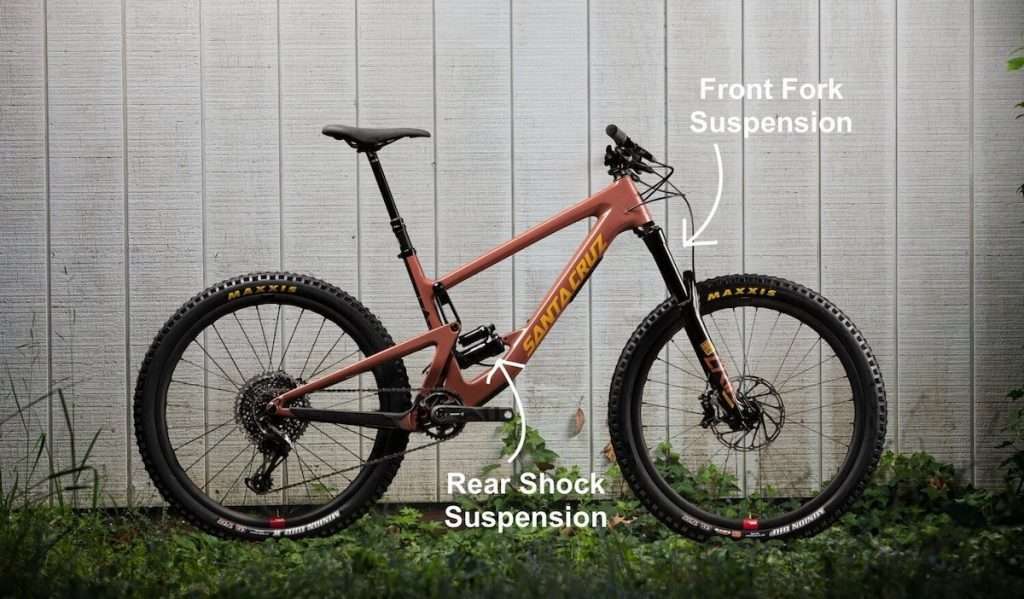
A note about hardtail bikes: If you’re eager and serious about getting into mountain biking, I highly recommend choosing a full-suspension bike as your first beginner mountain bike rather than a hardtail, which only has front fork suspension. Hardtails are less capable than full-suspension bikes on a variety of terrain and as your skills and fitness grow, you may feel held back on what you want to do.
Wheel size
Gone are the days of 26″ wheels on mountain bikes. Today, mountain bikes have two main wheel sizes to choose from: 27.5″ and 29″.
So which is better? I can’t answer that for you because every rider has their own preference when it comes to wheel size. I personally gravitate toward 27.5″ wheels because I find them to be more maneuverable and playful while many of my friends, brother, and sister-in-law are all on 29″ wheels.
If you’re not sure which wheel size you want, I recommend trying to demo both sizes to get a feel for their differences.
A few general guidelines are:
- Taller people tend to prefer 29″ wheels
- Shorter people tend to prefer 27.5″ wheels (some XS and S bikes only come with 27.5″ wheels)
- Cross-country riders tend to prefer 29″ wheels because they roll faster and are great for climbing
- Enduro or all-mountain riders tend to prefer either wheel size – it’s really personal preference
- Mullets are another option, which is actually what I prefer. These bikes have a 29″ wheel in the front and a 27.5″ wheel in the rear giving you the best of both worlds. Many bike brands are coming out with mullet options for their most versatile bike models.
Budget
Mountain bikes can range from $2,000 to $10,000 (or more). You can definitely find a great beginner mountain bike that is affordably priced, however, keep in mind that a $2,000 mountain bike will perform much differently than one twice that price.
If you’re just starting out and you want to invest in a bike that will last you several years, a good price range/budget is $3-4,000.
If you’ve already been shopping around for mountain bikes, you may have noticed that one bike will have several different price points. This is because you can get different components on the same bike (like brakes, derailleurs, drivetrains, etc…) ranging from basic to high-end.
Depending on your budget, the middle-of-the-road components are typically the best deal.
Frame material
Most mountain bikes have two options when it comes to frame material: aluminum or carbon. There are pros and cons when it comes to each material:
- Aluminum bikes tend to be heavier. But they’re also less expensive and they can take beatings better than carbon bikes (aluminum dents, carbon breaks).
- Carbon bikes are lighter. However, they are typically quite a bit more expensive than aluminum bikes and they run the risk of cracking or breaking under hard impacts. Carbon can be repaired more easily than aluminum bikes, though, if you can find a shop willing to do it.
6 Best Mountain Bikes For Beginners
Below are 6 great options for entry-level mountain bikes.
| Brand | Model | Wheel Size | F / R Suspension | Price |
|---|---|---|---|---|
| Devinci | Troy | 29″ | 150mm / 140mm | $3,779+ |
| Santa Cruz | Tallboy | 29″ | 130mm / 120mm | $3,599+ |
| Co-op Cycles | DRT 3.3 | Varies | Varies | $3,299 |
| Trek | Fuel EX | Varies | 150mm / 140mm | $3,700+ |
| Ibis | Ripmo | 29″ | 160mm / 147mm | $3,899+ |
| Canyon | Spectral | 29″ | 140mm / 125mm | $2,899 |
Looking for a deal on your first bike? The Pros Closet has an inventory of professionally serviced pre-owned bikes.
1. Devinci Troy
Starting at: $3,779
Suspension: 140mm rear / 150mm fork
Wheel size: 29″
Frame material: Aluminum, Carbon/Aluminum, Carbon
Best value model: Aluminum Deore 12S or Aluminum SX 12S
My first mountain bike was a Devinci Troy and I loved it! I also beat it to death… It’s a great choice for a first-time mountain bike because it’s a do-all bike that can handle almost anything on the trail. With 140mm of travel in the rear, it’s a mid-travel bike that can descend through chunky stuff with ease. Paired with 29″ wheels, it’s also optimized for climbing.
Devinci Cycles is a brand out of Montreal, Canada, but they have a decent-sized presence in the US, especially on the East Coast.
Both the aluminum Deore and SX models are great choices. The Shimano Deore components are slightly lighter than the SRAM SX components.
2. Santa Cruz Tallboy
Starting at: $3,599
Suspension: 120mm rear / 130mm fork
Wheel size: 29″
Frame material: Aluminum, Carbon
Best value model: Aluminum D or R
I’m a big Santa Cruz fan because I think they make great bikes. Sure, they are a little pricey, but Santa Cruz has really good warranties and I think their bikes are worth the price tag. Santa Cruz bikes also typically retain a high resale value.
For new riders, I would recommend the Santa Cruz Tallboy. It has 29” wheels, 120mm of rear travel, and 130mm of front fork suspension. The Aluminum D or R specs are great depending on your budget.
If you’re a woman, also check out the Juliana Joplin. It has the same geometry and specs as the Tallboy, but women-specific components and a lighter suspension tune.
Read next: A to Z List of Mountain Bike Brands
3. Coop Cycles DRT 3.3
Starting at: $3,299
Suspension: Rear travel not specified but probably around 100mm / 120mm (XS & S) 130mm (M-XL) fork
Wheel size: XS & S bikes have 27.5″ / M–XL have 29″
Frame material: Aluminum
Best value model: NA
A few years ago, REI introduced its own line of Co-op Cycles including a full-suspension mountain bike. The DRT 3.3 has a lot going for it as an entry-level mountain bike for beginners.
It’s designed to fit a wide range of riders from XS to XL, most notably because the XS and S come with 27.5″ wheels while the M-XL sizes come with 29″ wheels. This is because smaller frames don’t accommodate larger wheel sizes as well.
The XS and S sizes also have 10mm less travel, which is a bit weird…
However, if you’re looking for a good beginner mountain bike and you’re a loyal REI customer, the DRT 3.3 could be a good option. REI members get free flat fixes, 1 year of free adjustments, and 20% off shop services.
4. Trek Fuel EX
Starting at: $3,700
Suspension: 140mm rear / 150mm fork
Wheel size: 27.5″ or 29″ depending on frame size
Frame material: Aluminum, Carbon
Best value model: EX 7 Gen 6
Trek is one of the largest and most well-known mountain bike retailers in the world, so it’s no surprise that one of their bikes makes this list.
The Trek Fuel EX is a great beginner mountain bike because it has mid-range travel (140mm in the rear and 150mm up front), which is great for a wide variety of terrain from easy singletrack to more rough and rugged trails.
You can also find a Trek bike shop almost anywhere in the US, making it easy for tune-ups and repairs (although any full-service bike shop can help you out, too).
5. Ibis Ripmo
Starting at: $3,899
Suspension: 147mm rear / 160mm fork
Wheel size: 29″
Frame material: Aluminum, Carbon
Best value model: AF Deore (aluminum frame)
If you know you’re going to be shredding the slopes at the bike park or tackling big features even as a newbie, then the Ibis Ripmo AF (AF = aluminum frame) could be a great mountain bike for you. It comes with quite a bit of travel – 147mm in the rear and 160mm up front – but it has an aluminum frame to keep the price down and withstand abuse on the trail.
There are a couple of options available for the Ibis Ripmo AF but I think the Ripmo AF Deore model is a great entry-level option.
If you’re looking for something with a little less travel, check out the Ibis Ripley AF, which has 130mm up front and 120mm in the rear.
6. Canyon Spectral 125
Starting at: $2,899
Suspension: 125mm rear / 140mm fork
Wheel size: 29″
Frame material: Aluminum, Carbon
Best value model: Aluminum
I think Canyon makes some of the most beautiful bikes on the market including the Canyon Spectral 125. With an aluminum frame (or carbon), 29″ wheels, and short-travel suspension, this bike can handle both rowdy descents as well as steep climbs. It’s definitely a bike that you can grow with as a newer rider.
Another perk for Canyon Bikes is that they’re a direct-to-consumer brand, which cuts down on prices so you get more bike for your money.
Key takeaways
Choosing your first mountain bike is exciting, but it’s important to put some thought and time into figuring out what you want. There are a ton of options to choose from and some mountain bikes are a better fit for newer riders than others.
Here are a few guidelines as you do your research and shop around:
- I highly recommend getting a full-suspension bike instead of a hardtail if you plan on mountain biking a lot
- Try to demo or rent both 27.5″ wheels and 29″ wheels (or a mixed-wheel bike) to see which you prefer
- A short-travel or mid-travel bike is a good starter bike. I don’t recommend a long-travel or downhill bike as your first mountain bike.
Related posts:
- Mountain Bike Brands from A to Z
- 7 Questions to Ask When Buying A Used Mountain Bike
- How to Buy A Mountain Bike: 7 Easy Steps
What questions do you have about how to choose a beginner mountain bike? Which of these looks like the best fit for you? What other brands or models would you recommend? Let us know in the comments!




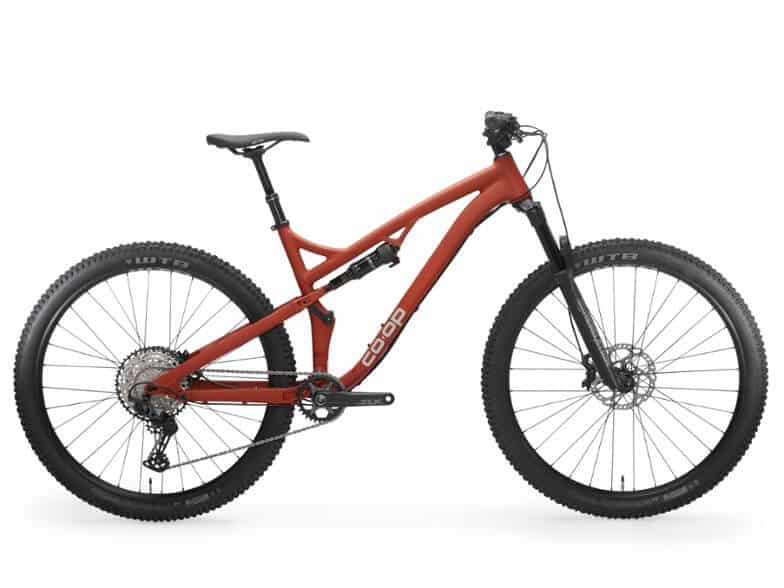
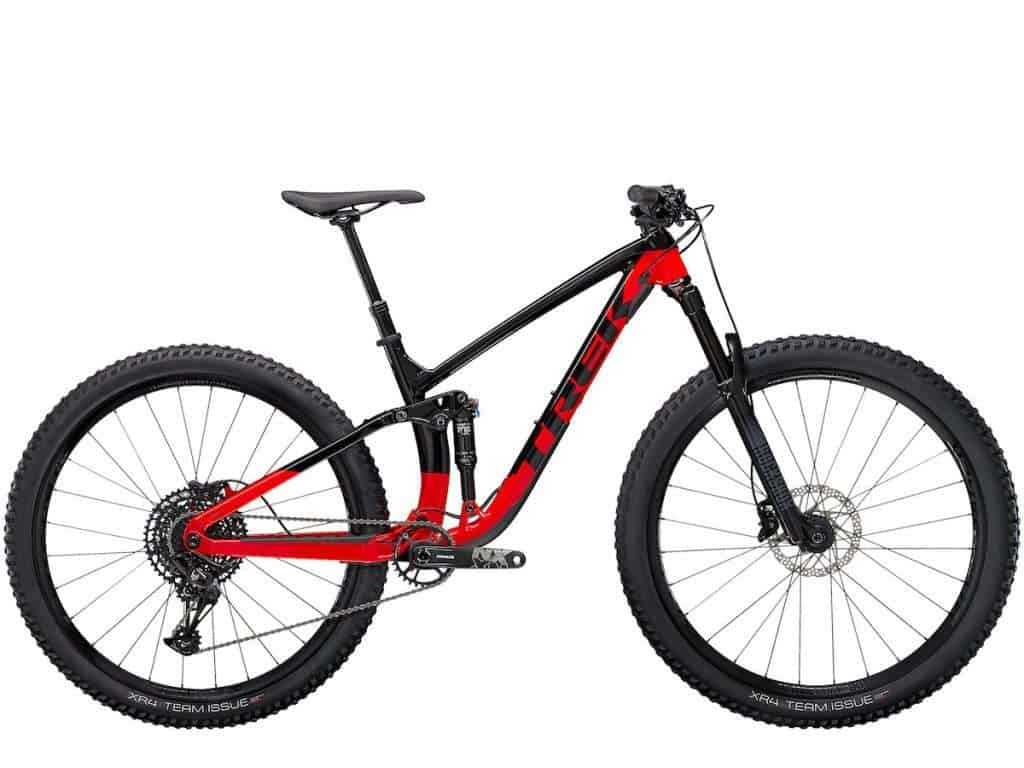
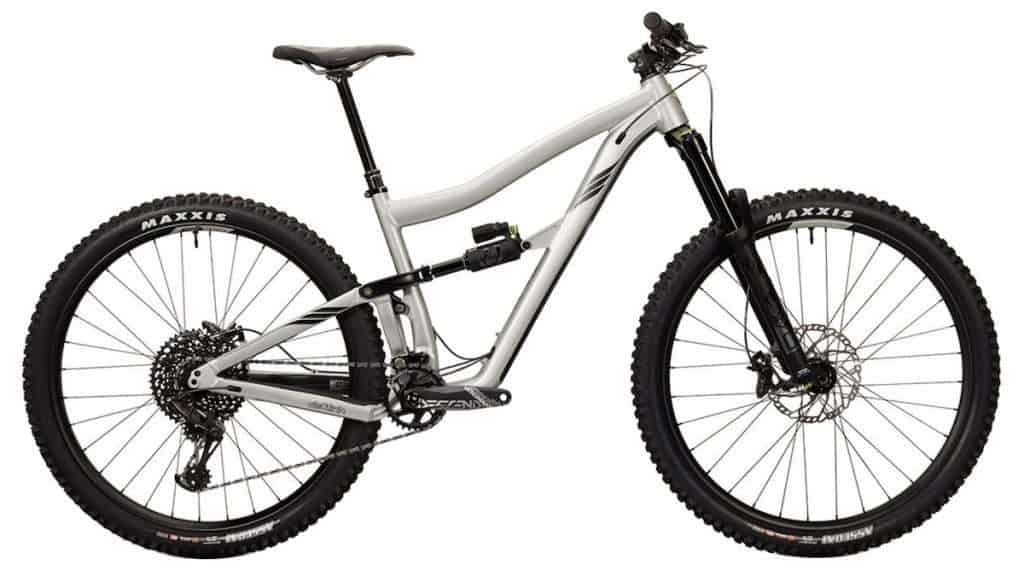

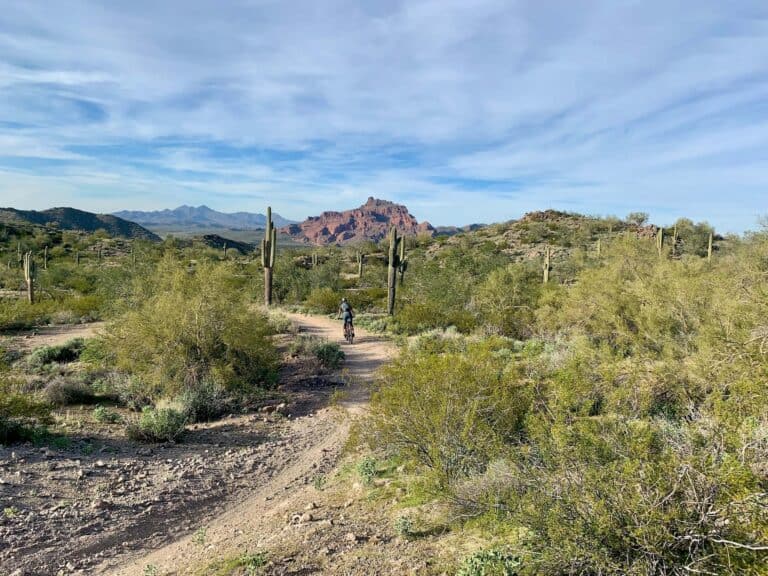
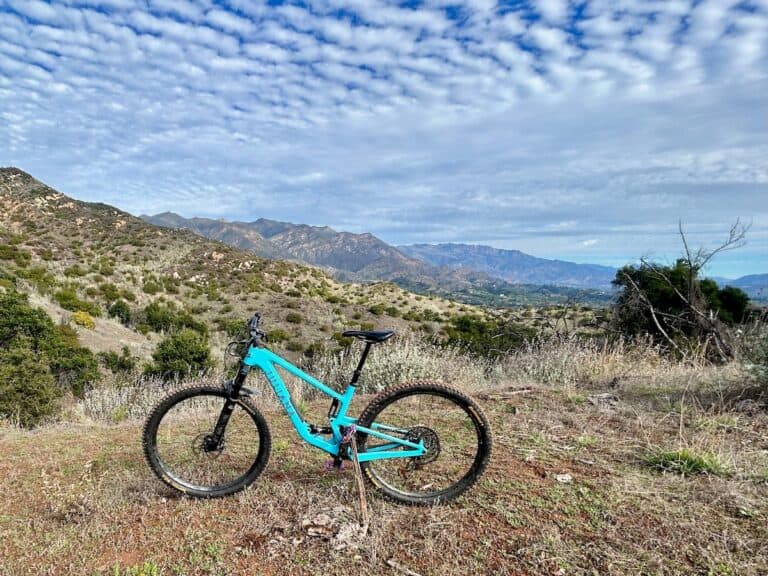
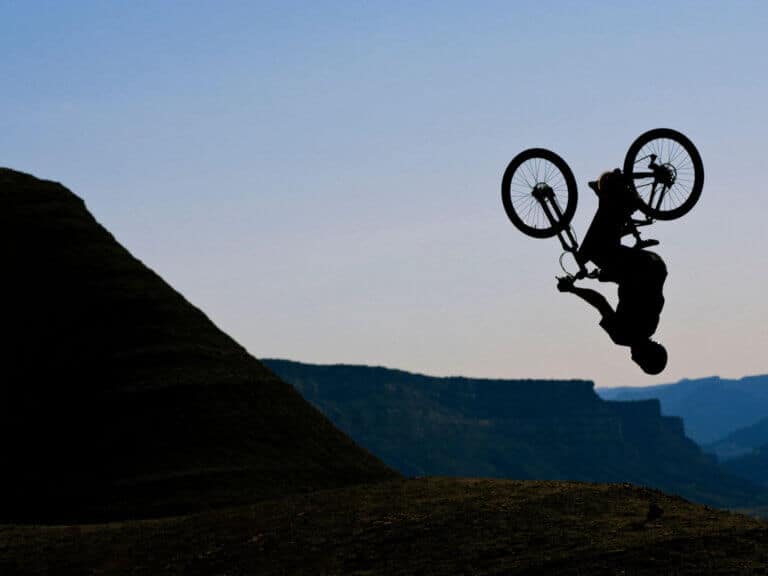



I love hearing from you and appreciate your comments! However, if you leave a rude, unconstructive, or spammy comment, it will be deleted. It’s cool to be kind. Have an awesome day!